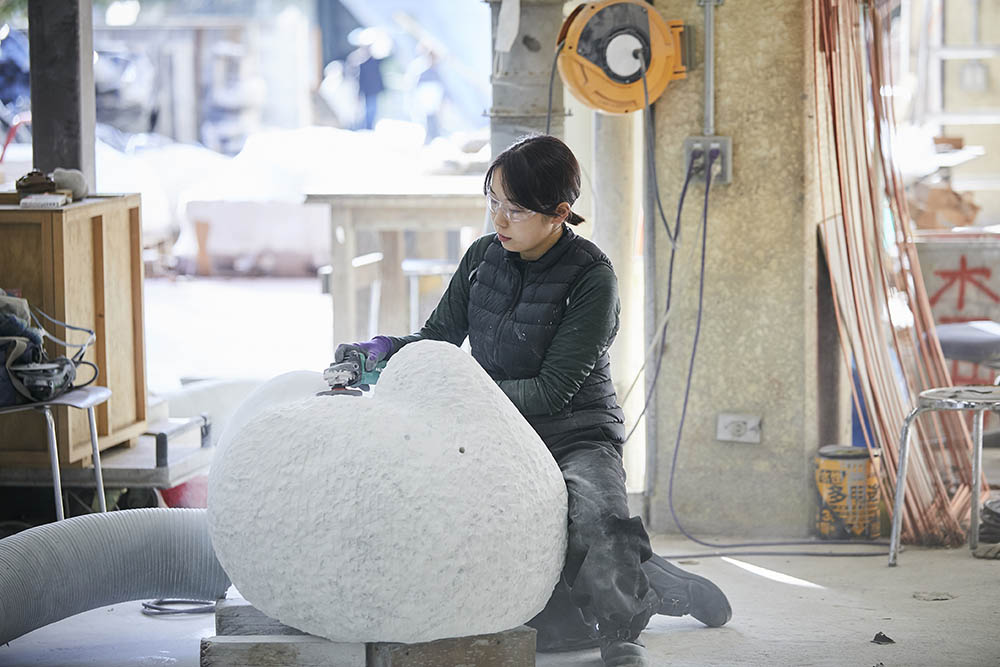Through our master's and doctoral programs, we nurture the artists and researchers who will contribute to the future development of art and culture using advanced, original forms of artistic expression combined with theoretical research that expands the possibilities of creative expression. With thorough, personalized instruction and a curriculum that emphasizes practical skills, our school supports the unique creative expression and research pursuits of our students.

Graduate School of Art Master’s Program
Fields: Oil painting, Japanese painting, Sculpture, Ceramics, Textiles, Printmaking, Video & Media Arts, Art theory
We train truly creative individuals who strive to discover the essence of art.
Truly creative expression begins with an inner dialogue: Why do I express myself? Why am I moved? And finally, what is art?
As you immerse yourself in creating your work and continue to explore, you will begin to make discoveries.
The Graduate School of Art at Kyoto Seika University provides students with ample time and a stimulating environment to facilitate this process of discovery.
This is where the artists and researchers who strive to uncover the essence of art are born.
One of Japan's best artistic production and research environments
Kyoto Seika boasts some of the most well-equipped facilities and largest production spaces of any art university in Japan, and our instructors, who are also active as artists, provide thorough and personalized instruction. Our campus allows students to devote themselves to their art, and under the strict, discerning eye of our professional faculty, we foster a high level of artistic expression in our students that endows them with creativity and universality. Even theoretical courses are taught alongside our production spaces, letting students deepen their research through hands-on activities.
Creating new forms of expression through exposure to a variety of technologies and media
As students sharpen their expertise in and learn about the unique characteristics of each field, they will be able to take a holistic approach to pursuing their mode of expression and challenge themselves using a variety of techniques and media formats. Because our coursework trains students to develop perspectives and ways of thinking not bound by existing concepts, they are able to work in a wide range of disciplines, from traditional to contemporary art.
A diverse range of initiatives to broaden perspectives and approaches
In our master’s program, students pursue their own artistic themes and style of expression by acquiring advanced, specialized knowledge and techniques in each field. At the same time, they also broaden their perspectives and approaches as artists and researchers through experiences outside of production, such as critiquing and discussing various works, exchanging opinions with artists and theoretical researchers in different fields, and engaging in projects outside the university. In addition, a system of joint instruction in practice and theory provides support from both technical and theoretical perspectives.
Course Instructors
The Joint Introductory Classes and Specialist Lecture Courses, which can be taken across our four graduate schools, host lectures by professionals working at the forefront of their respective fields, providing an even more hands-on education and research environment. In the Specialist Research Classes offered by each graduate school, experienced research advisors provide comprehensive guidance tailored to the research topics of each student.
Examples of Research Themes
● Consciousness and Transformation in Everyday Perception: Photography and 3D Objects
● Expression and Process in Japanese Painting: An Integrated Artistic Approach
Graduate School of Art Doctoral Program
Field: Art
Refine your own research and mode of expression.
The Graduate School of Art Doctoral program consists of three fields: “Fine Arts,” in which new works are created using traditional and modern techniques; “Design,” which delves into the aesthetic properties and functional rationality of objects and information while applying art and establishing its relationship to the real world; and “Media,” which explores the world of expression in media such as film that call for the expansion of consciousness. The main focus of this program is to complete a doctoral dissertation by exploring your own mode of expression and research more deeply and establishing it at an advanced level.
In addition, a system of joint instruction in practice and theory provides support from both technical and theoretical perspectives and fosters new developments in each student's area of research.
Examples of Research Themes
● From Matter to Spirit: Analyses of Materiality, Spirituality, and Ritual in Hendrawan Riyanto’s Artistic Practice
● Changes and Exchanges in Sino-Japanese Modern Design in the Time of the Republic of China: With a Focus on Chin Shifo
● A Study of Kneading in Modern Japan and Korea
● Reading Henri Michaux's Mouvements Memento: A Structuralist Approach
● The Significance of Avant-garde Documentary Theory in Post-war Society based on activities of Toshio MATSUMOTO until 1970
Academic Faculty
Graduate School Admission Information
For the Graduate School of Art application guidelines, refer to “Graduate School Admissions.”
